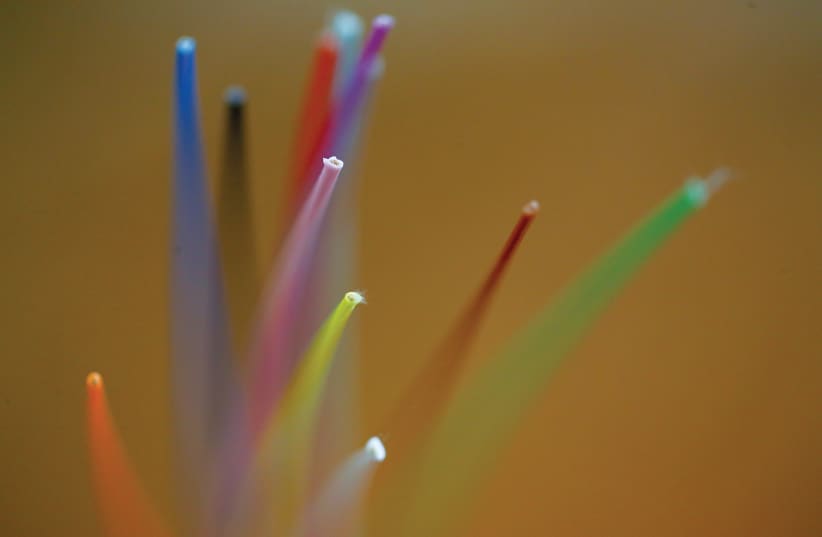“Fiber” is the word of the day, as Israel’s leading Internet providers begin to double down on selling access to the cutting-edge Internet technology. Cellcom, Hot and Bezeq are a few of the merchants waving their wares to the public, promising lightning-fast speeds unlike anything available in the past.
But those who don’t have their noses buried in the latest tech news may be left wondering what fiber Internet even is, and whether or not all this hype is justified.
Fiber: It's just not for breakfast anymore
Like all modern technologies, Internet tech has undergone a series of transformations since its initial implementation in the late 20th century. From Arpanet in ‘69 and dial-up in the ‘80s, all the way to modern Ethernet and Wi-Fi, each iteration improves on the last, granting users increased utility, convenience and speed with practically every advancement.
The latest in the long lineage of Internet connectivity options is fiber Internet, which promises to be the fastest and most reliable form of data transmission yet.
Fiber (short for fiber-optic) Internet uses small, flexible strands of glass to carry information in the form of light signals between sources. Information transfer via fiber takes place at a screaming 70% of the speed of light (the other 30% is chalked up to fiber-optic wires not being vacuums). A further benefit of fiber’s glass-based hardware is that unlike cable and DSL Internet, which use copper wires in order to carry information, fiber is completely immune to electrical interference, because there’s no electricity being transmitted through it.
Further adding to fiber’s growing list of advantages: It’s not only faster and more reliable, but it can also transmit more data than its copper counterparts – and typically with better quality.
Hendel with the sweet hookups
With such a massive value proposition, it’s no wonder that Communications Minister Yoaz Hendel has pushed forward a recent campaign to roll out fiber availability to every corner of the country, or as Hendel put it, “from Dimona and the Jordan Valley, to Amirim in the North to Eilat in the South.”
According to new data from the Communications Ministry, as of July 2022, more than 1.6 million households in Israel have access to fiber Internet, and about 670,000 households subscribe to fiber already. While fiber in Israel is now mostly available in cities and high-density residential zones, the Communications Ministry intends to broaden access to the country’s periphery and rural areas.
“We are continuing to connect Israel. The fiber revolution has turned from a dream into a reality on the ground in two years,” said Hendel. “The public has learned to understand the potential of ultra-fast Internet to change our lives and bring tremendous economic growth. There is a tremendous demand for fiber, and the public is satisfied with it. This is not only happening in big cities. The reform makes sure that fiber is already being deployed simultaneously in the periphery and the borders, and by the end of the year there will be access to 70% of Israel.”
Besides increasing the speed at which its citizens can stream the latest Marvel movie on Disney+, the Israeli government has a huge incentive to make high-speed Internet available from border to border.
“We are continuing to connect Israel. The fiber revolution has turned from a dream into a reality on the ground in two years.”
Communications Minister Yoaz Hendel
According to a study from the World Bank published in June, the chance of an educated population finding a job increases by 7%-13% when it has access to fiber-optic Internet, which could mean a huge increase in available workers from periphery groups such as Arabs and ultra-Orthodox Jews.
Furthermore, an increase of just 1% in the use of fixed (non-mobile) communications infrastructure can increase a country’s GDP by 0.08%. This, coupled with the obvious benefit of businesses being able to work faster thanks to quicker Internet, makes the effort to roll out fiber a great investment.
Is it worth its weight in glass?
Once they understand the benefits and potential of fiber, it’s ultimately up to consumers to decide if it’s worth cutting their cable Internet and making the switch. The good news is that Israeli service providers are making that migration pretty affordable.
There are a range of options available, and results and prices will vary based on negotiation and current membership. At a glance, and without including additional fees that apply, the monthly rate for a 600-megabyte fiber package from leading providers ranges from Bezeq’s NIS 129/month plan for the first 12 months to Hot’s NIS 109/month package after three months of paying NIS 59.
Whether or not the time is right for a given Internet user to hop on the bandwagon will vary on a case-by-case basis, but increased availability and widespread adoption will likely only lead to lowering prices as time goes on. The question is whether people are willing to wait that long for exponentially shorter buffer times on the latest episode of Fauda.

